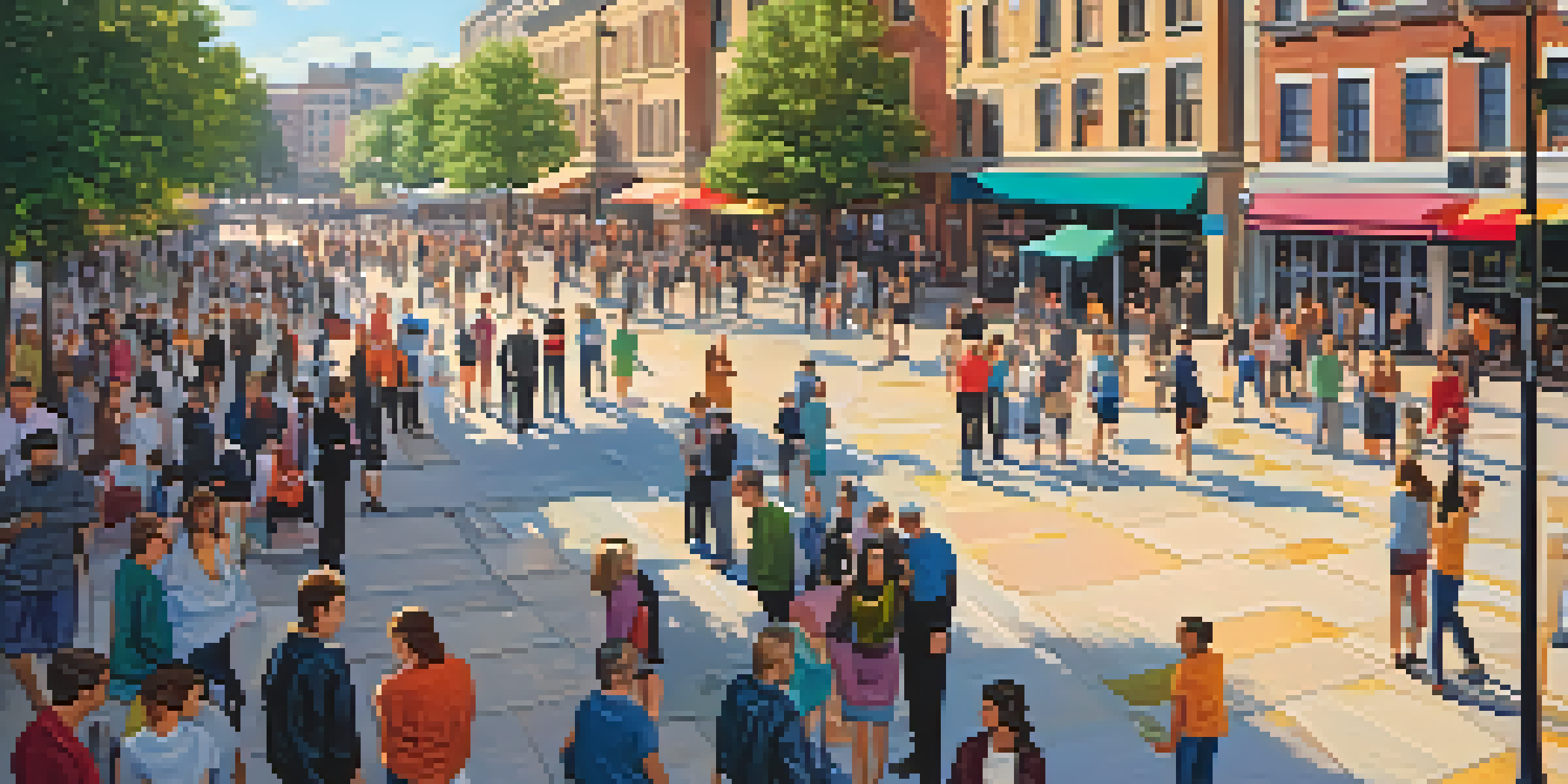Enhancing Public Safety with Smart Surveillance Technologies

Understanding Smart Surveillance Technologies
Smart surveillance technologies refer to advanced systems that use artificial intelligence and data analytics to monitor public spaces. These systems can identify suspicious behaviors, recognize faces, and even analyze crowd dynamics. By leveraging large datasets, they provide real-time insights that help law enforcement respond effectively to potential threats.
The advancement of surveillance technology is a double-edged sword; it can enhance safety but also threaten privacy.
Imagine walking through a busy city square and knowing that intelligent cameras are keeping an eye out for unusual activity. This proactive approach allows authorities to act before a situation escalates, making communities feel safer. The integration of smart surveillance isn't just about watching; it's about understanding and responding.
Moreover, these technologies are designed to respect privacy while enhancing security. With features that allow for data anonymization and ethical monitoring, communities can trust that their safety measures do not come at the cost of their personal freedoms.
Benefits of Smart Surveillance in Public Spaces
The primary benefit of smart surveillance technologies is the enhancement of community safety. With real-time monitoring, law enforcement can react to incidents as they unfold, potentially preventing crimes before they happen. This immediacy not only helps reduce crime rates but also increases public confidence in safety measures.

For example, in cities that have adopted smart surveillance systems, there's often a noticeable drop in vandalism and theft. When people know they're being watched, they tend to think twice about engaging in illegal activities. This psychological deterrent is a powerful tool for maintaining order in public spaces.
Smart Surveillance Enhances Safety
Advanced surveillance systems use AI to monitor public spaces, helping law enforcement prevent crime and improve community safety.
Additionally, these technologies can assist in emergency response, providing valuable data during crises. Whether it's a natural disaster or a public disturbance, smart surveillance can help authorities coordinate their efforts and allocate resources more efficiently.
Challenges and Concerns with Surveillance Systems
Despite the advantages, the implementation of smart surveillance technologies is not without challenges. Privacy concerns are at the forefront, as citizens fear that constant monitoring could infringe on their rights. Balancing safety and privacy is a critical issue that requires transparent policies and community engagement.
In the age of information, data is the new currency, and it must be protected like a precious resource.
Additionally, there’s the risk of data misuse. If sensitive information collected by surveillance systems falls into the wrong hands, it could lead to significant breaches of trust. Therefore, strict regulations and security protocols are essential to protect this data and ensure it’s used only for its intended purpose.
Lastly, the technology itself can sometimes be flawed or misinterpreted. For instance, false positives in facial recognition can lead to wrongful accusations. Continuous improvements and training for law enforcement personnel are crucial to mitigate these risks and maintain the integrity of the system.
Real-World Applications of Smart Surveillance
Cities around the world are already harnessing smart surveillance technologies to improve safety. For instance, in London, an extensive network of cameras equipped with AI has significantly reduced crime rates in high-risk areas. This real-world application illustrates the potential of these technologies to create safer environments.
Another notable example is the use of smart surveillance in public transportation systems. By monitoring train stations and bus routes, authorities can quickly identify and address issues, such as fare evasion or disturbances. This proactive approach not only enhances safety but also improves the overall commuter experience.
Balancing Privacy and Security
Implementing smart surveillance requires careful consideration of privacy concerns to maintain public trust and ensure ethical use of data.
Such applications demonstrate that smart surveillance can be tailored to meet specific community needs. Whether it’s crowd management at events or monitoring public parks, these systems can adapt to various environments, making them versatile tools for enhancing public safety.
The Role of AI in Smart Surveillance Systems
Artificial Intelligence (AI) is a game-changer in the realm of smart surveillance. By employing machine learning algorithms, these systems can analyze vast amounts of data quickly, identifying patterns and anomalies that might escape human notice. This efficiency is crucial in bustling urban settings where incidents can occur rapidly.
For example, AI can help filter through hours of footage to find specific events, making investigations much more efficient. Instead of sifting through endless video, law enforcement can receive alerts about relevant activities, saving time and resources. This technology not only speeds up response times but also enhances the overall effectiveness of surveillance.
However, while AI offers remarkable capabilities, it’s essential to ensure transparency in how these systems operate. Understanding the algorithms behind the technology can help build trust within communities, as people are more likely to support measures they understand and feel comfortable with.
Integrating Smart Surveillance with Community Needs
To maximize the effectiveness of smart surveillance technologies, it's vital to integrate them with community needs. Engaging local residents in discussions about safety concerns and surveillance measures can foster a sense of ownership and responsibility. This collaborative approach ensures that the systems in place align with the values and expectations of the community.
For instance, communities can provide input on where surveillance cameras should be placed to cover high-crime areas while respecting privacy concerns. This participatory model not only enhances safety but also strengthens the bond between law enforcement and residents, creating a more cohesive community.
Community Engagement is Key
Involving local residents in discussions about surveillance can lead to better alignment with community needs and strengthen relationships with law enforcement.
Moreover, regular feedback from the community can help authorities fine-tune their surveillance strategies. By adapting to the evolving needs of residents, smart surveillance can become a dynamic tool that evolves alongside the community it serves.
Looking Ahead: The Future of Smart Surveillance
The future of smart surveillance technologies is bright, with ongoing advancements paving the way for even more effective public safety measures. As technology evolves, we can expect improvements in accuracy, efficiency, and integration with other systems, such as emergency response and urban planning. This continuous evolution will help communities stay one step ahead of potential threats.
Furthermore, as public awareness grows, there will likely be more discussions around ethical considerations and regulations. Striking the right balance between safety and privacy will be crucial in shaping the future landscape of surveillance. Transparent policies and community involvement will play key roles in ensuring that these technologies are implemented responsibly.

Ultimately, smart surveillance has the potential to redefine public safety. By embracing these technologies while remaining mindful of ethical implications, communities can create safer environments for all residents, ensuring that safety and personal freedoms coexist harmoniously.